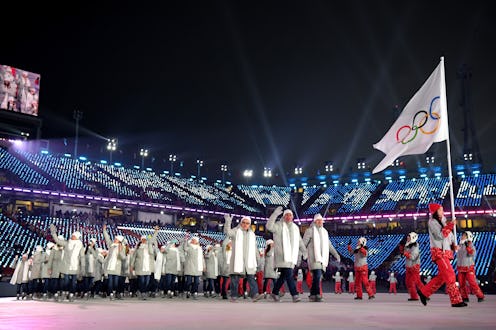News
The Number Of OARs At The Olympics Has People Wondering How The Ban On Russia Really Works

The big news in the lead up to the 2018 PyeongChang Games was that the International Olympic Committee had leveled a ban on Russia for a state-sponsored doping program they'd reportedly been running in the Sochi and Rio Olympics. In the end, though, dozens of Russian athletes are competing in PyeongChang as "Olympic Athletes from Russia." There are so many of them, and they have such potential for success, that the question of how many Olympic Athletes from Russia there are raises another question entirely: is the ban really doing anything?
In total, 169 OARs will be competing in PyeongChang across numerous sports and disciplines. When the IOC first announced the ban in December, IOC head Thomas Bach made it clear that athletes who could prove that they had never been involved in Russia's state-sponsored doping program would still be able to compete in PyeongChang. The deal, however, was that the Russian athletes would not be allowed to compete bearing the Russian flag, they would have to wear neutral uniforms at all times, and they would be referred to as "Olympic Athletes from Russia," or OARs.
Athletes have competed under a neutral Olympic flag before, with one memorable example being the team of refugees from various countries that competed together in the 2016 Rio Summer Games. This ban on Russian athletes competing under their own flag, however, was the first time that the IOC had ever imposed that penalty for a doping scandal.
The exact number of OARs competing in PyeongChang became clear only immediately before the games, as dozens of banned athletes struggled to push through last minute legal challenges to their bans. And even with those athletes still banned from this year's competition, 169 is still a fairly big team. Compare that number with the 242-athlete American delegation, which is the biggest delegation that any country has ever sent to any Winter Games.
In addition to those 169 athletes, Russia has also sent plenty of fans and supporters — and they don't have to abide by that whole ban on the flag. Whereas the OARs may be competing in single-color uniforms or marching in the opening ceremony in bland, gray outfits, their supporters are heavily decked out in the Russian white, blue, and red.
Russia, like all other countries competing at the games, even has a national gathering point, which they're referring to as the "Sports House." The word Russia may not be there, but the entire place is decked out with Russian patriotic symbols, like matryoshka dolls, medals from previous Olympic games, and Soviet hockey jerseys. A jersey bearing the letters "CCCP" in the Cyrillic alphabet (the acronym USSR rendered in Russian), after all, does not constitute a violation of the ban, as the country no longer exists and the Russian Federation is only its biggest successor state.
Many of those 169 OARs could also end up with some serious success in PyeongChang. While any medals that the OARs win will not count towards Russia's overall Olympic medal count, each one will still please those patriotic fans.
Speed skater Semen Elistratov already collected a bronze wearing his gray sweatshirt, and he dedicated his victory to "all guys that have been excluded from these Games in such a hard and unfair way." The figure skaters from Russia have already come out strong. And perhaps most importantly to the Russian public, the hockey team made up of Olympic Athletes from Russia — the same team that Russia would have sent in different uniforms had they not received the ban — has the best chance of winning Olympic gold that the nation has had in decades.
It's no wonder, then, that critics of the way the IOC has carried out the ban say that it's not going to have any effect. Asterisked though these medals will be, they're still victories on sports' biggest stage — and they'll still have a nation of engaged fans cheering and waving flags, right where the athletes can see them.